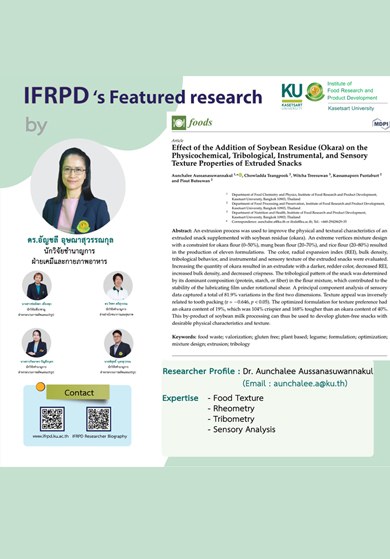
บทสรุป : กากถั่วเหลืองผลพลอยได้จากกระบวนการแปรรูปนมถั่วเหลืองถูกนำมาพัฒนาเป็นขนมขบเคี้ยวปราศจากกลูเตน ตอบสนองความต้องการอาหาร plant based และเป็นวัตถุดิบที่มีศักยภาพในระบบเศรษฐกิจหมุนเวียน
Abstract : An extrusion process was used to improve the physical and textural characteristics of an extruded snack supplemented with soybean residue (okara). An extreme vertices mixture design with a constraint for okara flour (0–50%), mung bean flour (20–70%), and rice flour (20–80%) resulted in the production of eleven formulations. The color, radial expansion index (REI), bulk density, tribological behavior, and instrumental and sensory texture of the extruded snacks were evaluated. Increasing the quantity of okara resulted in an extrudate with a darker, redder color, decreased REI, increased bulk density, and decreased crispness. The tribological pattern of the snack was determined by its dominant composition (protein, starch, or fiber) in the flour mixture, which contributed to the stability of the lubricating film under rotational shear. A principal component analysis of sensory data captured a total of 81.9% variations in the first two dimensions. Texture appeal was inversely related to tooth packing (r = −0.646, p < 0.05). The optimized formulation for texture preference had an okara content of 19%, which was 104% crispier and 168% tougher than an okara content of 40%. This by-product of soybean milk processing can thus be used to develop gluten-free snacks with desirable physical characteristics and texture.
Foods Volume 2022, 11, 2967






